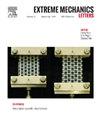Multi-axed phase-transforming cellular material: A data-driven design and validation using finite-element method and machine learning
IF 4.5
3区 工程技术
Q2 MATERIALS SCIENCE, MULTIDISCIPLINARY
引用次数: 0
Abstract
We developed the novel Atom-Mimetic Cube-Diagonally Multi-Axed Phase-Transforming Cellular Material (AMCDMA-PXCM), hereafter AM-PXCM for short, for a multi-axial bistable metamaterial designed with inspiration from a face-centered cubic (FCC) crystal structure: the designed AM-PXCM consists of spheres at atomic positions of structure and dogleg-shaped beams connecting nearest neighbor spheres. Stress-strain relationship of AM-PXCM was investigated by Finite Element Method (FEM) simulation. Analyzing the results by Logistic classification revealed that the mechanical properties significantly depend on the designing parameters and the distance between the beam and the tetrahedron (k) dominantly determines the bistability of the FCC-based AM-PXCM. In addition, combined with the machine learning method (i.e., inverse design), we succeeded to predict the designing parameters to have the desired mechanical properties for a bistable metamaterial. The designed AM-PXCMs were realized using a 3D printer and validified to show the predicted mechanical properties. This established method for developing AM-PXCM is suggested to be also applied to a development of an AM-PXCM with the symmetry of other crystal structures.
多轴相变细胞材料:使用有限元方法和机器学习的数据驱动设计和验证
我们从面心立方(FCC)晶体结构中获得灵感,设计了一种多轴双稳态超材料——仿原子立方对角多轴相变细胞材料(AMCDMA-PXCM),以下简称AM-PXCM:设计的AM-PXCM由位于原子位置的球体和连接最近相邻球体的狗腿形光束组成。采用有限元模拟方法研究了AM-PXCM的应力应变关系。Logistic分类分析结果表明,设计参数对AM-PXCM的力学性能有显著影响,梁与四面体之间的距离(k)主要决定了基于fcc的AM-PXCM的双稳定性。此外,结合机器学习方法(即逆设计),我们成功地预测了具有双稳态超材料所需力学性能的设计参数。利用3D打印机实现了所设计的am - pxcm,并对其力学性能进行了验证。提出了一种开发AM-PXCM的方法,该方法也适用于开发具有其他晶体结构对称性的AM-PXCM。
本文章由计算机程序翻译,如有差异,请以英文原文为准。
求助全文
约1分钟内获得全文
求助全文
来源期刊

Extreme Mechanics Letters
Engineering-Mechanics of Materials
CiteScore
9.20
自引率
4.30%
发文量
179
审稿时长
45 days
期刊介绍:
Extreme Mechanics Letters (EML) enables rapid communication of research that highlights the role of mechanics in multi-disciplinary areas across materials science, physics, chemistry, biology, medicine and engineering. Emphasis is on the impact, depth and originality of new concepts, methods and observations at the forefront of applied sciences.
 求助内容:
求助内容: 应助结果提醒方式:
应助结果提醒方式:


